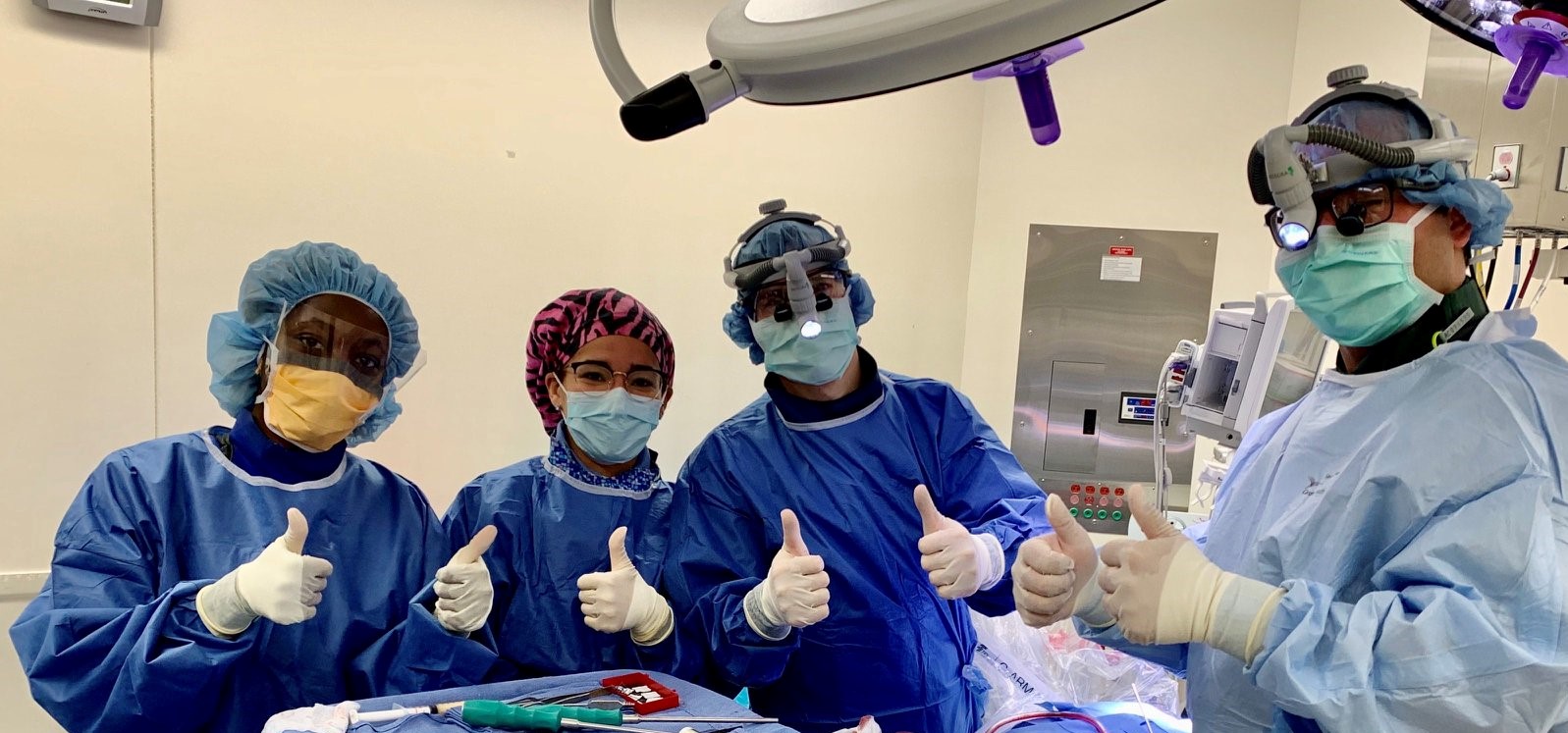Cervical Endoscopic Spine Surgery
Patients suffering from a pinched nerve in the neck now have an ultra-minimally invasive surgical option: cervical endoscopic spine surgery. This advanced surgical technique can provide immediate relief for patients suffering from pain, numbness and/or weakness radiating down the shoulder and arm. Compared to traditional methods, cervical endoscopic spine surgery produces less pain and a rapid recovery.
“Endoscopic spine surgery is performed through an incision that is approximately eight millimeters -- less than a centimeter – in length,” said Peter Derman, M.D., a spine surgeon on the medical staff at Texas Health Center for Diagnostics and Surgery. “But the beauty of endoscopic surgical techniques is not just the small incision. It’s what happens under the skin that makes a dramatic difference.”
Read more to learn about this exciting procedure.
Understanding Cervical Endoscopic Spine Surgery

Ultra-minimally invasive cervical endoscopic spine surgery is often used to treat a pinched nerves. Here is a quick definition of terms:
“Cervical” refers to the cervical spine (or neck) region. The neck is part of the spinal column, or backbone, and consists of seven bones (called the C1-C7 vertebrae), which are separated from one another by intervertebral discs. These discs allow the spine to move freely and act as shock absorbers during activity.
“Endoscopic” means the surgeon uses an endoscope, a small camera that is placed into the body via a narrow tube. The surgeon uses the camera to see inside the spine as he or she works. Endoscopic spine surgery may be used for a variety of conditions in different areas of the spine.
A “pinched nerve” is a condition that occurs when pressure is applied to a nerve by surrounding tissues, such as bone spurs or disc bulges. In the neck, this can result in pain, tingling, numbness and/or weakness traveling to the shoulder or down the arm. Cervical endoscopic spine surgery is often a good option for treating this condition ifs conservative measures (such as medication or physical therapy) have failed to provide relief.
Ultra-minimally invasive is the newest and least invasive level of surgical spine techniques. “There's a whole spectrum of surgical techniques from the traditional spine surgery to minimally invasive techniques, which involve a smaller incision and less muscle damage,” said Dr. Derman. “The next iteration is endoscopic surgery, or ultra-minimally invasive surgery, which uses a camera through an extremely small incision. By making that leap where we’re using a camera, rather than looking at the spine with our eyes or with a microscope, we make an even smaller incisions, which means less tissue damage. For the patient, it means an even quicker recovery.”
An Alternative to Traditional Surgery
Until the development of minimally invasive techniques, spine surgery was exclusively performed as "open surgery." The area being operated on was opened with a long incision to allow the surgeon to view and access the anatomy. One of the major drawbacks was that the surgeon detached the muscles around the spine and then moved them to the side in order to access the spine and underlying issues. This produces damage to the muscle and other surrounding soft tissues. As a result, patients often experienced significant pain from the surgery itself. Traditional surgery also required a lengthier recovery period and posed a higher risk of infection and blood loss. 
While many surgeons still perform open surgery, technological advances have allowed specialized surgeons to treat more back and neck conditions with minimally invasive, and now ultra-minimally invasive, surgical techniques.
“These techniques can be applied to anywhere in the spine – the low back, the midback, and the neck,” said Dr. Derman. “The common thread between all of them is that they use smaller incisions and cause less muscle damage.”
With ultra-minimally invasive surgery, the surgeon uses an endoscope (a small camera similar to that used in knee and shoulder arthroscopic surgery) to access the problem area in the spine.
“This little camera goes in between the muscle fibers,” said Dr. Derman. “That’s the key because you’re not creating that collateral damage to get to the spine, and that typically results in less pain after surgery and a faster recovery.”
During surgery, Dr. Derman monitors video from the tiny camera on a high-definition screen and performs the surgery using micro-instruments.
“I use these tiny 3-4 mm shavers and graspers to clean out around the nerves,” he said. “I remove whatever may be pushing on the nerves, whether it’s disc material or bone spurs, so there’s nothing compressing the nerve by the end of the procedure.”
“Next, the camera is removed, the patient gets a stitch under the skin to close the incision, and a tiny dressing – basically a glorified Band-aid – is placed over it. Patients go home the same day, require minimal (if any) pain medications after surgery, and are often back to most of their normal activities the following day,” said Dr. Derman.
For many patients, endoscopic techniques also allow surgeons to precisely target the problem area, eliminating the need for fusion – a procedure where surgeons connect two adjacent vertebrae to help eliminate pain.
“Fusion has some disadvantages: it’s a longer procedure, usually involves a longer recovery, and it eliminates motion in the area of the spine where the procedure is performed,” said Dr. Derman. “I’ve been able to perform many outpatient, endoscopic, non-fusion surgeries on people who would've otherwise required a fusion. These patients were able to get up and get moving right away, and they didn’t lose any of the motion that they had.”
Choosing Cervical Endoscopic Spine Surgery
Cervical endoscopic spine surgery is performed while the patient is under anesthesia and usually takes an hour to 1.5 hours. The surgery is performed on an outpatient basis, in contrast to the 1-2 day hospital stay that traditional surgery may require.
“Most patients go home the same day after surgery,” Dr. Derman said. “Very little pain medication is necessary; in fact, I often have patients who just take Tylenol. Patients can be active as soon as they feel comfortable doing so. I'm totally okay with them walking as much as they want, even on the day of surgery. I had one patient recently who told me she was at the gym on the elliptical less than 24 hours after her spine surgery, which was pretty incredible.”
Regardless of operative technique, surgery is usually recommended only if nonsurgical treatments — such as medications and physical therapy — do not relieve the painful symptoms. The risks of cervical endoscopic spine surgery are relatively low, but every procedure involves inherent risks. These include infection, bleeding, blood clots, or recurrent symptoms.
For Dr. Derman, performing ultra-minimally invasive cervical spine surgery is gratifying personally, because, for most of his patients, the surgery leads to immediate relief.
“The most common experience of our patients is that their arm pain is dramatically better immediately after surgery,” he said. “Patients are thrilled. For me, it’s so rewarding to see these patients who had horrible symptoms that are now essentially gone.”
Wondering if you could be a candidate for endoscopic spine surgery? Click the link below to take our endoscopic spine assessment!

